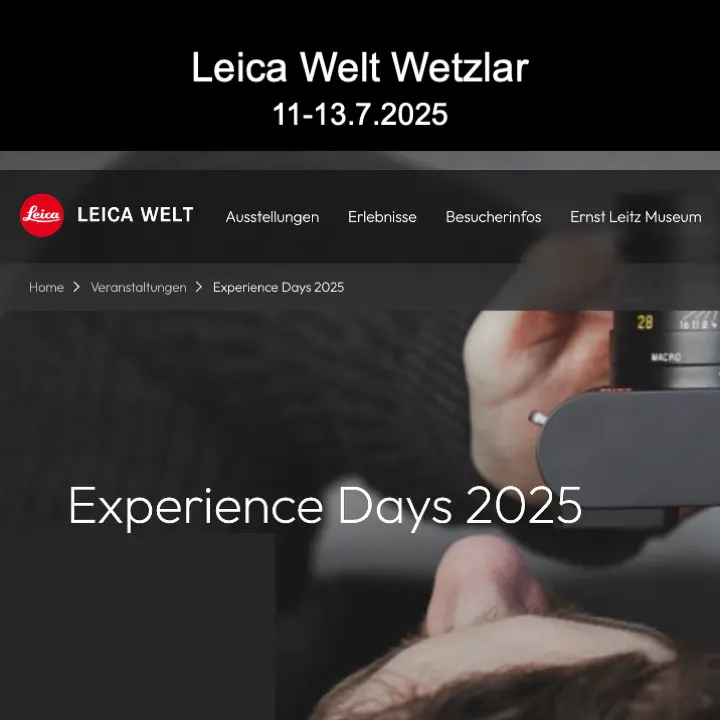Searching for content in photography
How do you find your questions in your images? What distinguishes mere reproduction from true interpretation?
A few quotes accompany me on this path:
“I try with my pictures to raise a question.” – Sebastião Salgado
“The difference between reproducing and interpreting the world is precisely what separates the artist from the artisan” – Philippe Litzler
My special point of contact for these questions is Hans-Jürgen Burkard. I met him at the DGPh and now again in Baden near Vienna – at the La Gacilly-Baden Photo Festival, Europe’s largest outdoor exhibition. He won the World Press Photo Award (1991 und 1992) and the prestigious German Erich Salomon-Preis (2021).

Burkard’s photos impress me: They show what is, play with stereotypes, surprise – and make you think. In conversation, he told me how his projects come to life. His book An Tagen wie diesen (On Days Like These) is an inspiring example:
🎵 Music as a Starting Point
He let himself be guided by German songs like Tage wie diese, searching for motifs that fit the mood and lyrics.
🗺️ Travel & Openness
Over 20,000 km across Germany, always ready to stop spontaneously and discover something new.
📸 Associative Photography
Not looking for the obvious, but for situations that reflect emotions.
✏️ Image & Text in Dialogue
He combines each photo with lines from song lyrics – creating a dense narrative layer.
🧩 Mosaic Instead of Chronology
He arranges his pictures as a poetic mosaic of fragments, not as a linear story.

👉 A few practical tips from him:
• Focus on what people represent – not just their faces.
• Create calm backgrounds, e.g., by going low so the sky appears behind them.
• Stay open to chance – but when an opportunity arises, do everything to capture the image.

✅ Conclusion
Burkard’s method – Song → Journey → Chance Motifs → Text-Image Dialogue → Collage – offers a powerful framework for your own photographic projects. If you combine music, travel, and photography, you can create images that truly make an impact.
Have fun exploring!

Auf der Suche nach Inhalten in der Fotografie
Auf der Suche nach Inhalten in der Fotografie
Wie finde ich meine Fragen in meinen Bildern? Was unterscheidet bloßes Reproduzieren von echter Interpretation?
Ein paar Zitate begleiten mich auf diesem Weg:
„Ich versuche mit meinen Bildern eine Frage aufzuwerfen“ – Sebastião Salgado
„Reproduzieren oder interpretieren – hier trennt sich der Handwerker vom Künstler.“ – Philippe Litzler

Mein besonderer Ansprechpartner bei diesen Fragen ist Hans-Jürgen Burkard. Ich habe ihn bei der DGPh kennengelernt und später in Baden bei Wien wiedergetroffen – beim Fotofestival La Gacilly-Baden Photo, Europas größter Outdoor-Ausstellung. Er gewann den World Press Photo Award (1991 und 1992) und den renommierten Erich-Salomon-Preis (2021).
Burkards Fotos beeindrucken mich: Sie zeigen, was ist, bedienen zum Teil Stereotype, überraschen aber auch und regen zum Nachdenken an. Im Gespräch hat er mir erzählt, wie seine Projekte entstehen. Sein Buch An Tagen wie diesen ist ein inspirierendes Beispiel:
Short über das Buch von Hans-Jürgen Burkard:
https://www.youtube.com/shorts/foUKPrjHTU0 (Opens in a new window)
🎵 Musik als Ausgangspunkt
Er ließ sich von deutschen Songs wie Tage wie diese leiten, suchte Motive, die zu Stimmung und Text passen.
🗺️ Reise & Offenheit
Über 20.000 km durch Deutschland, immer bereit, spontan anzuhalten und Neues zu entdecken.
📸 Assoziatives Fotografieren
Nicht das Offensichtliche suchen, sondern Situationen, die Emotionen spiegeln.
✏️ Bild & Text im Dialog
Jedes Foto kombiniert er mit Zeilen aus Songtexten – daraus entsteht eine dichte Erzählungsebene.
🧩 Mosaik statt Chronologie
Er ordnet seine Bilder als poetisches Fragment-Mosaik, keine lineare Story.

Ein paar konkrete Tipps von ihm:
• Konzentriere dich auf das, was Menschen darstellen – nicht nur auf Gesichter.
• Sorge für ruhige Hintergründe, z.B. indem du tief gehst und den Himmel einbeziehst.
• Sei offen für Zufälle – aber wenn sich eine Gelegenheit ergibt, tu alles, um das Bild zu machen.
Fazit
Burkards Methode – Song → Reise → Zufallsmotive → Text-Bild-Dialog → Collage – bietet ein kraftvolles Gerüst für eigene Fotoprojekte. Wenn du Musik, Reisen und Fotografie verbindest, kannst du Bilder schaffen, die wirklich etwas bewegen.
Viel Freude beim Ausprobieren!
What’s next?
https://www.fotogipfel-oberstdorf.de/ (Opens in a new window)Meet and Street in Dresden
Gathering of Germán Street photographers in the city of the Dresden
12 July 2025
https://www.streetcollective-dresden.de/meetandstreet25 (Opens in a new window)Inspiration & Book Recommendations / Inspiration & Buchempfehlungen
Association Initiative Mensch und Natur e.V. I M u N
 (Opens in a new window)
(Opens in a new window)LezArtistes EnPoche
The Collective “LezArtistes EnPoche” just released the latest edition:
Das Kollektiv „LezArtistes EnPoche“ hat gerade die neueste Ausgabe veröffentlicht:
 (Opens in a new window)
(Opens in a new window)
More to come:
Was noch so kommt:
 (Opens in a new window)
(Opens in a new window) (Opens in a new window)
(Opens in a new window)Check out open spots:
Freie Plätze in meinen Workshops:
 (Opens in a new window)
(Opens in a new window) (Opens in a new window)
(Opens in a new window)To know more about…
Um mehr zu erfahren…
Website https://www.piaparolin.com/ (Opens in a new window)
Instagram, Facebook @piaparolinphoto
YouTube Pia`s Journey youtube.com/@piaparolin
https://www.youtube.com/@piaparolin (Opens in a new window)LinkedIn https://www.linkedin.com/in/piaparolin/ (Opens in a new window)
Linktree https://linktr.ee/piaparolinphoto (Opens in a new window)
Books (in German): https://dpunkt.de/?s=Pia+Parolin&post_type=product (Opens in a new window)
Thank you!
If you like my newsletter, please share it with others. And I'm always happy to receive feedback: photo@piaparolin.com (Opens in a new window). Thanks!
Wenn dir mein Newsletter gefällt, teile ihn gerne mit anderen. Und ich freue mich immer über Feedback: photo@piaparolin.com (Opens in a new window). Danke!

